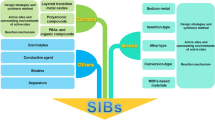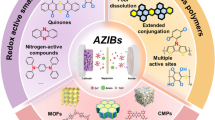Abstract
We have studied the electrochemical performance of the δ-5 boron monolayer as an anode material for alkali metal (AM) and alkaline earth metal (AEM) ion batteries using density-functional theory simulations. The electronic properties, adsorption, diffusion rate, and storage behavior of various metal atoms (M) in the δ-5 boron monolayer are explored. Our study shows that the δ-5 boron monolayer possesses high electrical conductivity and a low activation barrier for electron and metal-ion transit (0.493–1.117 eV), indicating a fast charge/discharge rate. Furthermore, the theoretical capacities of the δ-5 boron monolayer for Li, Na, and K are found to be greater than those of commercial graphite. The average open-circuit voltage for AM and AEM is reasonably low and in the range of 0.34–1.30 V. Our results show that δ-5 boron monolayer could be a promising anode material in lithium-ion and non-lithium-ion rechargeable batteries.
Graphical abstract








Similar content being viewed by others
Data availability
The datasets generated during and/or analyzed during the current study are available from the corresponding author on reasonable request.
Code availability
Not applicable.
References
J.P. Barton, D.G. Infield, Energy storage and its use with intermittent renewable energy. IEEE Trans. Energy Conv. 19(2), 441 (2004)
M. Lowe, S. Tokuoka, T. Trigg, G. Gereffi, Lithium-ion batteries for electric vehicles. US Value Chain Contrib. CGGC Res. 90(2), 156–162 (2010)
N. Nitta, F. Wu, J.T. Lee, G. Yushin, Li-ion battery materials: present and future. Mater. Today 18(5), 252 (2015)
A. Ponrouch, M.R. Palacín, Post-Li batteries: promises and challenges. Philos. Trans. R. Soc. A 377(2152), 20180297 (2019)
C. Delmas, Sodium and sodium-ion batteries: 50 years of research. Adv Energy Mater. 8(17), 1703137 (2018)
M.D. Slater, D. Kim, E. Lee, C.S. Johnson, Sodium-ion batteries. Adv. Funct. Mater. 23(8), 947 (2013)
Y. Wu, Y. Yu, 2D material as anode for sodium ion batteries: Recent progress and perspectives. Energy Storage Mater. 16, 323 (2019)
Y. Liu, B.V. Merinov, W.A. Goddard, Origin of low sodium capacity in graphite and generally weak substrate binding of Na and Mg among alkali and alkaline earth metals. Proc. Nat. Acad. Sci. 113(14), 3735 (2016)
B. Ji, F. Zhang, X. Song, Y. Tang, A novel potassium-ion-based dual-ion battery. Adv. Mater. 29(19), 1700519 (2017)
K. Chayambuka, G. Mulder, D.L. Danilov, P.H. Notten, Sodium-ion battery materials and electrochemical properties reviewed. Adv Energy Mater. 8(16), 1800079 (2018)
E. Peled, The electrochemical behavior of alkali and alkaline earth metals in nonaqueous battery systems—the solid electrolyte interphase model. J. Electrochem. Soc. 126(12), 2047 (1979)
J.K.S. Goodman, P.A. Kohl, Effect of alkali and alkaline earth metal salts on suppression of lithium dendrites. J. Electrochem. Soc. 161(9), D418 (2014)
L. Shi, T. Zhao, Recent advances in inorganic 2D materials and their applications in lithium and sodium batteries. J. Mater. Chem. A 5(8), 3735 (2017)
L. Wang, Z. Wei, M. Mao, H. Wang, Y. Li, J. Ma, Metal oxide/graphene composite anode materials for sodium-ion batteries. Energy Storage Mater. 16, 434 (2019)
M. Gu, Y. He, J. Zheng, C. Wang, Nanoscale silicon as anode for Li-ion batteries: the fundamentals, promises, and challenges. Nano Energy 17, 366 (2015)
C. Zhang, M. Yu, G. Anderson, R.R. Dharmasena, G. Sumanasekera, The prospects of phosphorene as an anode material for high-performance lithium-ion batteries: a fundamental study. Nanotechnology 28(7), 075401 (2017)
H. Hwang, H. Kim, J. Cho, MoS2 nanoplates consisting of disordered graphene-like layers for high rate lithium battery anode materials. Nano Lett. 11(11), 4826 (2011)
Y. Jiang, M. Hu, D. Zhang, T. Yuan, W. Sun, B. Xu, M. Yan, Transition metal oxides for high performance sodium ion battery anodes. Nano Energy 5, 60 (2014)
Q. Tang, Z. Zhou, P. Shen, Are MXenes promising anode materials for Li ion batteries? Computational studies on electronic properties and Li storage capability of Ti3C2 and Ti3C2X2 (X= F, OH) monolayer. J. Am. Chem. Soc. 134(40), 16909 (2012)
D. Chen, G. Ji, B. Ding, Y. Ma, B. Qu, W. Chen, J.Y. Lee, Double transition-metal chalcogenide as a high-performance lithium-ion battery anode material. Ind. Eng. Chem. Res. 53(46), 17901 (2014)
M. Aydinol, A. Kohan, G. Ceder, K. Cho, J. Joannopoulos, Ab initio study of lithium intercalation in metal oxides and metal dichalcogenides. Phys. Rev. B 56(3), 1354 (1997)
C.M. Julien, A. Mauger, K. Zaghib, H. Groult, Comparative issues of cathode materials for Li-ion batteries. Inorganics. 2(1), 132 (2014)
X. Liu, X. Zhu, D. Pan, Solutions for the problems of silicon–carbon anode materials for lithium-ion batteries. R. Soc. Open Sci. 5(6), 172370 (2018)
X. Chen, Y. Zhang, The main problems and solutions in practical application of anode materials for sodium ion batteries and the latest research progress. Int. J. Energy Res. 45(7), 9753 (2021)
L. Kong, K. Wu, L. Chen, Recent progress on borophene: growth and structures. Front. Phys. 13(3), 1 (2018)
L. Adamska, S. Sadasivam, J.J. Foley IV., P. Darancet, S. Sharifzadeh, First-principles investigation of borophene as a monolayer transparent conductor. J. Phys. Chem. C 122(7), 4037 (2018)
D. Liu, D. Tománek, Effect of net charge on the relative stability of 2D boron allotropes. Nano Lett. 19(2), 1359 (2019)
H. Tang, S. Ismail-Beigi, First-principles study of boron sheets and nanotubes. Phys. Rev. B 82(11), 115412 (2010)
X. Wu, J. Dai, Y. Zhao, Z. Zhuo, J. Yang, X.C. Zeng, Two-dimensional boron monolayer sheets. ACS Nano 6(8), 7443 (2012)
W.-C. Yi, W. Liu, J. Botana, L. Zhao, Z. Liu, J.-Y. Liu, M.-S. Miao, Honeycomb boron allotropes with Dirac cones: a true analogue to graphene. J. Phys. Chem. Lett. 8(12), 2647 (2017)
S. Zhang, X. Hu, Q. Lu, J. Zhang, Density Functional Theory Study of Arsenic and Selenium Adsorption on the CaO (001). Surf. Energy Fuels. 25(7), 2932 (2011)
C. Zhu, S. Lin, M. Zhang, Q. Li, Z. Su, Z. Chen, Ultrahigh capacity 2D anode materials for lithium/sodium-ion batteries: an entirely planar B7P2 monolayer with suitable pore size and distribution. J. Mater. Chem. A 8(20), 10301 (2020)
K.T. Chan, J.B. Neaton, M.L. Cohen, First-principles study of metal adatom adsorption on graphene. Phys. Rev. B 77(23), 235430 (2008)
Z. Yang, Y. Zheng, W. Li, J. Zhang, Tuning the electrochemical performance of Ti3C2 and Hf3C2 monolayer by functional groups for metal-ion battery applications. Nanoscale 13(26), 11534 (2021)
H. Xu, H. Chen, C. Gao, Advanced graphene materials for sodium/potassium/aluminum-ion batteries. ACS Mater. Lett. 3(8), 1221 (2021)
Y. Zhang, X. Xia, B. Liu, S. Deng, D. Xie, Q. Liu, Y. Wang, J. Wu, X. Wang, J. Tu, Multiscale graphene-based materials for applications in sodium ion batteries. Adv. Energy Mater. 9(8), 1803342 (2019)
Y. Jing, Z. Zhou, C.R. Cabrera, Z. Chen, Metallic VS2 monolayer: a promising 2D anode material for lithium ion batteries. J. Phys. Chem. C 117(48), 25409 (2013)
Y. Jing, E.O. Ortiz-Quiles, C.R. Cabrera, Z. Chen, Z. Zhou, Layer-by-layer hybrids of MoS2 and reduced graphene oxide for lithium ion batteries. Electrochim. Acta 147, 392 (2014)
K. Liu, B. Zhang, X. Chen, Y. Huang, P. Zhang, D. Zhou, Modulating the open-circuit voltage of two-dimensional MoB MBene electrode via specific surface chemistry for Na/K ion batteries: a first-principles study. J. Phys. Chem. C 125(33), 18098 (2021)
X. Lv, F. Li, J. Gong, J. Gu, S. Lin, Z. Chen, Metallic FeSe monolayer as an anode material for Li and non-Li ion batteries: a DFT study. Phys. Chem. Chem. Phys. 22(16), 8902 (2020)
R. Yazami, Y.F. Reynier, Mechanism of self-discharge in graphite–lithium anode. Electrochim. Acta 47(8), 1217 (2002)
K. Persson, V.A. Sethuraman, L.J. Hardwick, Y. Hinuma, Y.S. Meng, A. Van Der Ven, V. Srinivasan, R. Kostecki, G. Ceder, Lithium diffusion in graphitic carbon. J. Phys. Chem. Lett. 1(8), 1176 (2010)
Y. Ren, Z. Liu, F. Pourpoint, A.R. Armstrong, C.P. Grey, P.G. Bruce, Nanoparticulate TiO2 (B): an anode for lithium-ion batteries. Angew. Chem.. 124(9), 2206 (2012)
M. Mortazavi, C. Wang, J. Deng, V.B. Shenoy, N.V. Medhekar, Ab initio characterization of layered MoS2 as anode for sodium-ion batteries. J. Power Sources. 268, 279 (2014)
Z. Jian, W. Luo, X. Ji, Carbon electrodes for K-ion batteries. J. Am Chem. Soc. 137(36), 11566 (2015)
H. Jiang, Z. Lu, M. Wu, F. Ciucci, T. Zhao, Borophene: a promising anode material offering high specific capacity and high rate capability for lithium-ion batteries. Nano Energy 23, 97 (2016)
Acknowledgments
AK thanks University Grants Commission (UGC), New Delhi, for financial support in the form of a Junior Research Fellowship (DEC18-512569-ACTIVE). PP thanks DST-SERB for ECRA Project (ECR/2017/003305).
Author information
Authors and Affiliations
Corresponding author
Ethics declarations
Conflict of interest
On behalf of all authors, the corresponding author states that there is no conflict of interest.
Additional information
Publisher's Note
Springer Nature remains neutral with regard to jurisdictional claims in published maps and institutional affiliations.
Supplementary Information
Below is the link to the electronic supplementary material.
Rights and permissions
Springer Nature or its licensor holds exclusive rights to this article under a publishing agreement with the author(s) or other rightsholder(s); author self-archiving of the accepted manuscript version of this article is solely governed by the terms of such publishing agreement and applicable law.
About this article
Cite this article
Kumar, A., Parida, P. Theoretical study of δ-5 boron monolayer as an anode material for Li- and non-Li-ion batteries. Journal of Materials Research 37, 3384–3393 (2022). https://doi.org/10.1557/s43578-022-00734-8
Received:
Accepted:
Published:
Issue Date:
DOI: https://doi.org/10.1557/s43578-022-00734-8




